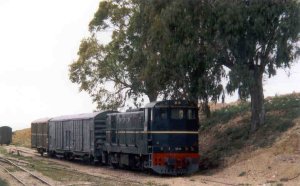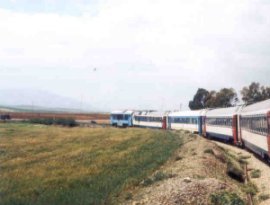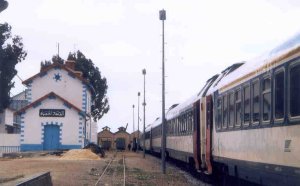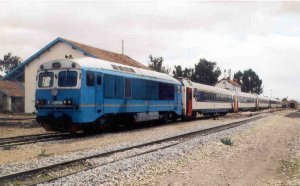ENTRE LES MONTAGNES
"LA LIGNE DU SUD-OUEST"
TUNIS - GAAFOUR - KALAA KHASBA - HAÏDRA - KASSERINE
LES SALINES - EL KEF
Longueur/Länge/Length:
Tunis - Kasserine 318 km; Les Salines - El Kef 31 km; Fej et Tameur - Sidi
Amor Ben Salem 25 km; Bir Kassa - La Goulette ca. 10 km (Marchandises/Güter/Freight)
Traffic voyageurs / Personenverkehr / Passenger services: Tunis - Kalaa
Khasba 235 km
Ecartement / Spurweite / Gauge: 1000 mm
Ouvert au traffic / Eröffnet / Opened to traffic: Tunis - Bir Kassa
- Depienne - Pont du Fahs - Gaafour - Les Salines - Fej et Tameur - Oued
Sarrath (223 km) 1897-1905; Bir Kassa - La Laverie (ca. 5 km) 1897; Depienne
- Zaghouan (12 km) 1898; Les Salines - El Kef 1906; Fej et Tameur - Sidi
Amor Ben Salem - Slata (29 km) ca. 1907; Oued Sarrath - Kalaat Es Senam (30
km) ca. 1910; Oued Sarrath - Kalaa Khasba (Kalaa Djerda) - Haïdra
- Aïn Kerma - Algerie/Algerien (38 km) 1931; Haïdra - Kasserine
(65 km) 1940 & 1965;
Fermé à tout traffic/Stillgelegt/ Closed: Depienne - Zaghouan
1948; Oued Sarrath - Kalaat Es Senam 1959; Haïdra - Algérie
ca. 1961; Haïdra - Kasserine 1942-1965
Les Salines - El Kef: Réouvert au traffic voyageurs/Wiedereröffnet/Reopened for passengers 2011
La Ligne de Tunis vers
Kasserine quitte la ligne principale vers le sud à la gare de banlieue
Jebel Jelloud. En passant par Bir Kassa et Nassen, des gares qui ont vues
un service de banlieue pendant plusieurs années, avant l'ouverture
de la ligne du Métro Léger, elle atteint la province. La ligne
traverse une région qui est intensivement cultivée. Déjà
pour les Romains cette région était importante pour le ravitaillement
de Carthage. A partir du train on aperçoit très souvent l'acquéduct
qui transportait l'eau douce de l'Oued Miliana vers les colonies romaines
sur la côte. Non loin de Pont du Fahs se trouvent les traces de la
ville romaine de Thuburbo Majus. Maintenant la ligne continue vers l'ouest
en passant entre les montagnes Jebel Mansour au sud avec 678 m d'altitude
et le Jebel Rihane au nord avec ses de 720 m. Près d'El Aroussa la
ligne plonge dans la vallée de l'Oued Siliana et un peut plus tard
le train arrive à Gaafour, un centre régional. Non loin la
ligne fait le détour autour du Jebel Akhouat (hauteur 607 m) pres
de la gare du même nom. La chaine de montagnes ne s'arrête pas
et peut après Sidi Bou Rouis on passe au flanc est du Jebel Maiza
avec ses 887 m. La ligne continue à monter le long des fleuves tributaires
de l'Oued Mejerda et ses confluents et à Dahmani elle atteint la hauteur
de 622 m. Autour de cette vallée les montagnes atteindent des hauteurs
de plus de 1000 mètres et à environ 20 km au nord-ouest de
Kalaa Khasba la fameuse Table de Jugurtha s'élève à
1271 m. A Kalaa Khasba le service voyageurs se termine, mais la ligne
continue en passant par Haïdra avec sa ville romaine d' Ammaedara, ou
elle prend la direction sud-sud-est pour traversées la région
la plus accidentée de toute la Tunisie. La construction du tronçon
Haïdra - Kasserine à necesité le percement de plusieurs
tunnels pour passer sous les Monts de Tebessa qui atteindent des altidues
de 1300 et 1400 mètres et la construction de ponts pour franchir notamment
l'Oued el Halab das la région de Foussana. Peut avant Kasserine la
ligne longe le pied du Jebel Chambi, avec 1544 m, le point culminant de
la Tunisie. A peut de distance de la ville romaine de Cillium la ligne entre
en gare de Kasserine.
 -
-
Manoeuvre de wagons
marchandises dans une gare de la ligne
Rangieren in einem Unterwegsbahnhof dieser Strecke
Shunting work is done in a wayside station of this line.
Die Strecke Tunis -
Kasserine verlässt die Hauptlinie Richtung Süden im Vorortsbahnhof
Jebel Jelloud. Kurz danach werden Bir Kassa und Nassen bedient, bis dahin
fuhren vor einiger Zeit noch Vorortszüge, bis die SMLT die Gegend besser
erschloss.Danach führt die Strecke in die Provinz hinaus. Die Strecke
führt durch eine landwirtschaftlich reich genutzte Gegend. Schon zur
Römerzeit war diese Gegend für die Versorgung von Karthago sehr
wichtig. Aus dem Zug erblickt man immer wieder die Reste des römischen
Aquäduktes, welcher mit Wasser aus dem Oued Miliana die Küstenorte
versorgte. Unweit von Pont du Fahs findet man die Überreste der römischen
Stadt Thuburbo Majus. Nun führt die Linie westwärts und erreicht
zu ihrer Linken den 678 m hohen Jebel Mansour und auf der anderen Seite
den 720 m hohen Jebel Rihane. Bei der Station El Aroussa taucht die Strecke
ins Tal des Oued Siliana ein und erreicht wenig später Gaafour, ein
regionales Zentrum. Kurz danach umfährt die Strecke den 607 m hohen Jebel
Akhouat bei der Station mit dem selben Namen. Die Gebirgskette reisst nicht
ab und kurz nach Sidi Bou Rouis führt die Strecke entlang des 887 m
hohen Jebel Maiza. Die Strecke steigt weiter an und folgten den verschiedenen
Quellflüssen des Oued Mejerda und dessen Zuflüssen und die Stadt
Dahmani liegt bereits auf 622 m Höhe. Rundherum reichen die Berge jetzt
bis auf Höhen von mehr als 1000 m und etwa 20 km nordwestlich von Kalaa
Khasba reicht der berühmte Table de Jugurtha auf 1271 m. In Kalaa Khasba
enden die Personenzüge, doch die Strecke führt im Güterverkehr
weiter nach Haïdra, mit der römischen Siedlung Ammaedara. Hier
schwenkt die Strecke nach süd-südost ab und führt durch die
gebirgigste Gegend ganz Tunesiens. Der Bau der Linie Haïdra - Kasserine
erforderte die Bohrung mehrerer Tunnels durch die 1300 bis 1400 m hohen Tebessa
Berge und den Bau von Brücken über den Oued Halab bei Foussana.
Kurz vor Kasserine liegt das Geleise am Fusse des Jebel Chambi, mit 1544 m
der höchste Punkt von ganz Tunesien. Unweit der römischen Stadt
Cillium mündet die Strecke in den Bahnhof von Kasserine.

La région vers
Kalaa Khasba est verdoyante et riche en cultivations agricoles.
Die Gegend in Richtung Kalaa Khasba ist grün und reich ladwirtschaftlich
genutzt.
The region to Kalaa Khasba is green and intensively used for agriculture.
The Tunis - Kasserine
line leaves the Southern main line at Jebel Jelloud suburban station. Shortly
afterwards the train calls at Bir Kassa and Nassen stations, both have been
served by suburban trains before SMLT services reached this part of Tunis
suburbs. Then the line reaches the countryside. The line traverses an agriculturally
important region and even Romans used this region for cultivations to feed
Carthago city. From the train you'll see at many places parts of the old
Roman aqueduct, which brought water from the Oued Miliana river to the coastal
places. Not far from Pont du Fahs you can visit the remains of Thuburbo Majus,
a Roman city. Now the line goes westbound and reaches the first mountains,
in the South is Jebel Mansour with 678 m and to the North is 720 m high Jebel
Rihane. Near El Aroussa station the line enters into the Oued Siliana Valley
and reaches a bit later Gaafour, a regional hub. Shortly after Gaafour the
line winds its way around 607 m high Jebel Akhouat with its namesake station.
The mountains does not end and near Sidi Bou Rouis the line is on the foot
of 887 m high Jebel Maiza.The line continues to climb and it follows many
of the feeder rivers of Oued Mejerda. Dahmani city is at 622 m above sea
level. Here the mountains are reaching tops of more than 1000 metres. About
20 km Northwest of Kalaa Khasba the famous Table de Jugurtha is reaching 1271m.
Passenger trains ends at Kalaa Khasba, from now on the line is freight only
and continues to Haïdra with its Roman ruins called Ammaedara. At Haïdra
the line swings South-Southeast and reaches the 1300 to 1400 m high Tebessa
Mountains, the most mountainous region of Tunisia. Building this line made
boring of tunnels through the Tebessa Mountains necesary and bridges have
been built over Oued Halab near Foussana. A few kilometres before reaching
Kasserine the line follows the foot of Jebel Chambi, with 1544 m the highest
point of Tunisia. In a long curve the line passes the Roman ruins of Cillium
before entering Kasserine station.

La gare de Kalaa
Khasba, ancienne Kalaa Djerda
Der Bahnhof von Kalaa Khasba, ehemals Kalaa Djerda genannt
Kalaa Khasba station, formerly called Kalaa Djerda.

Kalaa Khasba, Train
Omnibus climatisé avec locomotive Ganz-Mávag et voitures modernisées
pour Tunis avant le départ
Kalaa Khasba, klimatisierter Nahverkehrszug mit Ganz-Mávag Lok
und modernisierten Wagen vor der Abfahrt nach Tunis
Kalaa Khasba, air-conditioned local train with Ganz-Mávag built
locomotive and modernised coaches shortly before leaving for Tunis
Retour à l'entrée
Informations concernant la Carte Bleue
Les
Horaires de cette Ligne
Zurück zum Eingang
Informationen zur Carte
Bleue Die Fahrpläne dieser Linie
Back to entry
Information
about Carte Bleue Railpasses
The Schedules of this line
 -
-

